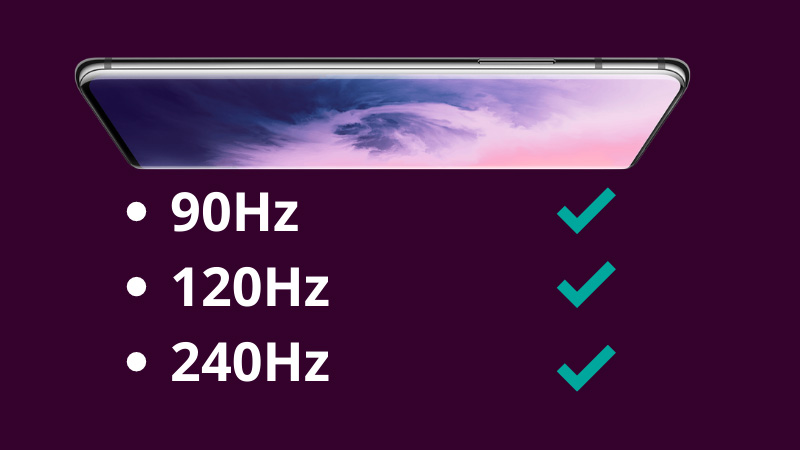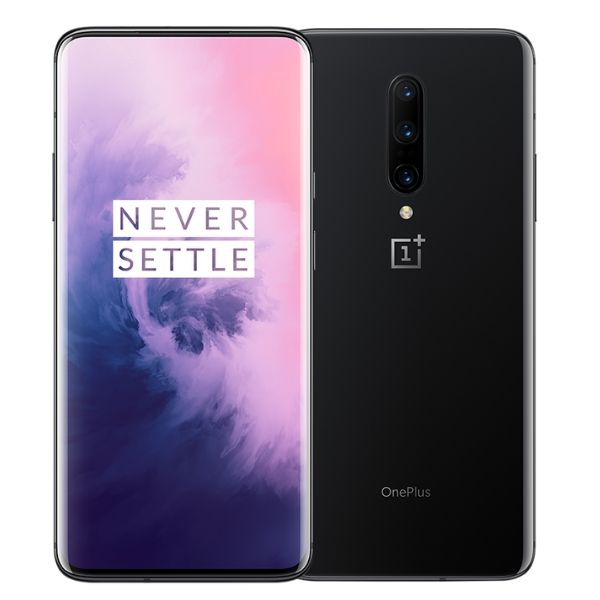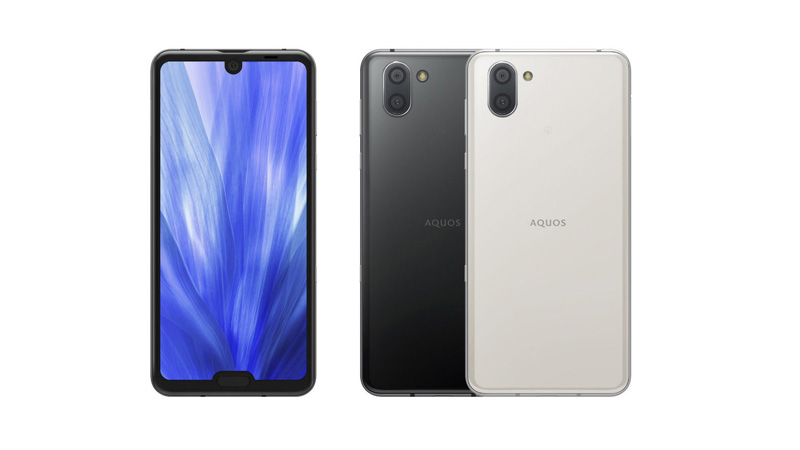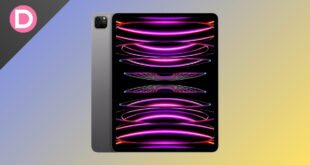90Hz refresh rate on smartphone displays is now a feature everybody wants. Before Oneplus introduced it on a smartphone, this was a feature we saw only on gaming PCs. But now, as much as everyone looks for AMOLED screens, flagship processors, and flagship cameras, we are seeing higher refresh rates being added to this list. As more and more phones use this new trending tech, we expect this to become quite mainstream in the coming years. Currently, though, there are only a few bunches of phones out there that have a higher than standard 60Hz refresh rate. Let’s take a detailed look at what this tech is all about. We have also discussed the few bunches of phones that offer a higher refresh rate and how they are good against each other in all the departments.
What is 90Hz and 120Hz Display?
90Hz or 120Hz refresh rate simply means that the screen will redraw everything on it 90 times or 120 times per second. The animation will be faster as the display is quicker to register all the changes. Coming from a standard 60Hz refresh rate, this will be a noticeable difference. Many assume that a higher refresh rate will mean that games will also run at a higher rate, but that’s not the case. For a game or any app to use a higher refresh rate, its developers need to implement it on the software side as well. So yes, the OS will run smoothly, and basic tasks like texting, switching between apps, and watching supported videos will be better. However, that’s not the case for every bit of smartphone use, as most of the apps will still run at 60Hz.
Touch Refresh Rate vs Display Refresh Rate
Another thing to keep in mind is the touch refresh rate. Sometimes, a display might have a high refresh rate, but a slower touch refresh rate pulls it down. Touch refresh is the time the screen takes to record touch on the screen at any point. The faster the refresh rate, the faster the CPU can act on it. Now, Apple has a slower refresh rate of 60 Hz but a higher-touch refresh rate of 120 Hz. And that is why iOS feels so smooth to use. Again, if we can get both the screen refresh rate and touch refresh rate high, the device will be extremely snappy to any touch. It will immediately register the touches and bring up things faster on the screen too. Certain gaming phones out there have already opted for a higher touch refresh rate than the refresh rate.
List of Best 90Hz Display Phones
- Realme 6
- Realme 6 Pro
- Black Shark 3
- Black Shark 3 Pro
- Oppo Reno 3 Pro 5G
- Oppo Reno Ace
- OnePlus 7 Pro
- Realme X2 Pro
- OnePlus 7T Pro
- OnePlus 7T
- Google Pixel 4
- Nubia Red Magic 3S
- Motorola Edge
- Motorola Edge+
- Oppo Find X2 Neo
- OnePlus 8
- Honor 30 Pro+
- Huawei P40 Pro
- Huawei P40 Pro+
- Oppo Ace2 5G
- Realme X50 Pro
- Xiaomi Mi 10
- Xiaomi Mi 10 Pro
- Sony Xperia 1 II
- Google Pixel 4
- Google Pixel 4 XL
- Vivo X50 Pro
- Vivo X50
- Honor 30 Lite
- Moto G 5G Plus
- OnePlus Nord 5G
- Realme Narzo
- Huawei Enjoy 20 Pro
- Oppo Reno4 Pro 5G
- Realme 6s
- Huawei Enjoy Z 5G
- Realme X50 Pro Play
- Honor X10 5G
- Meizu 17 Pro
- Meizu 17
List of Best 120Hz Display Phones
- Realme X50 5G
- Redmi K30 5G
- Poco X2
- Sharp Aquos R3
- Asus ROG Phone 2
- Samsung Galaxy S20
- Galaxy S20 Plus
- Samsung Galaxy S20 Ultra
- OnePlus 8 Pro
- Realme X50m 5G
- Oppo A92s
- Oppo Find X2
- Oppo Find X2 Pro
- iQOO Z1x
- Realme X3
- Realme X3 SuperZoom
- Vivo X50 Pro+
- Redmi K30i 5G
- Redmi K30 5G Racing Edition
Realme 6 and 6 Pro
Realme 6 and Realme 6 Pro smartphones come with Helio G90T and Snapdragon 720G Chipset, respectively. Both devices sport Full HD+ LCD panels with a 90Hz refresh rate and 120Hz touch sampling rate. They feature a 64MP main camera on the rear with a Samsung GW1 Sensor and pack a 4300mAh battery under the hood. However, the 6 Pro comes with 30W Super VOOC 4.0 Fast Charge technology, whereas Realme 6 supports 18W Fast Charge technology.
Black Shark 3 and 3 Pro
Black Shark 3 gaming smartphone, along with a Pro version called Black Shark 3 Pro, launched in China. Both packs 90Hz AMOLED display and 270Hz touch sampling rate. They run on Snapdragon 865 SoC under the hood with a liquid cooling system to mitigate thermal throttling. Both come with 65W charging technology.
Oppo Reno 3 Pro 5G
Chinese handset maker Oppo has unveiled a new smartphone called Oppo Reno 3 Pro with 5G support under its Reno series in its home market. The smartphone is powered by Qualcomm’s Snapdragon 765G 7nm EUV Mobile Platform coupled with 8GB LPDDR4X RAM + 128GB storage and 12GB LPDDR4X RAM + 256GB storage. The Reno 3 Pro 5G sports a 6.5-inch (2400 × 1080 pixels) AMOLED display with a 90Hz refresh rate, 97% NTSC color gamut, and 500nit brightness. It has a quad-camera module at the rear with a 48MP rear camera with a Sony IMX586 sensor and f/1.7 aperture. We have the latest Android 10 operating system with ColorOS 7.0 UI. There is a 4025mAh (Typical) battery that comes with support for 30W VOOC 4.0 fast charging.
Oppo Reno Ace
This is the first device from Oppo to come with a higher refresh rate display of 90 Hz and a touch sampling rate of 135Hz. This is a 6.5-inch FHD+ OLED panel, and together with Snapdragon 855 plus, this provides a smooth experience. We get a quad-camera setup on the back, too, with a dedicated macro mode lens of 2MP to go along with the 48MP primary lens, 13MP telephoto lens, and an 8MP wide-angle lens. But the most highlighted feature of Oppo Reno Ace is that it comes with a 4,000 mAh battery, which can be charged up completely in under 30 min using Oppo’s 65W Super VOOC technology.
OnePlus 7 Pro
It’s the device that started it all as a mainstream device. Oneplus always goes for speed with their phones while keeping the design and other aspects in check, and the Oneplus 7 Pro is an example of that. It has a 6.67-inch Fluid AMOLED FHD+ display with no notch at all and curves on the sides. The front camera works as a popping mechanism at the top of the device. Under the hood, we have the Snapdragon 855 with a 4,000 mAh battery and 30W fast charging. The highlight feature of this device was the fact that it has a fully immersive screen experience with a screen that has a refresh rate of 90Hz. Together with this hardware with OxygenOS, the experience is buttery smooth.
Realme X2 Pro
Probably the cheapest among the bunch, the Realme X2 Pro comes with a 90Hz 6.5-inch FHD+ AMOLED panel. It packs in the latest Snapdragon 855 Plus, UFS 3.0 storage for the higher variants, and 50W fast charging to top up a 4,000 mAh battery in just about half an hour. Another selling point for this phone is that it packs in the latest 64MP sensor from Samsung as the primary sensor with a quad-camera setup as a whole. It sports a small notch at the top of the front side, but the viewing experience with the higher refresh rate more than makes up for it. The value that one gets for their money with this device is by far the best as far as 90Hz display phones are concerned.
OnePlus 7T and 7T Pro
The successor to the previous device also comes with a higher refresh rate of 90Hz. This has marked the end of 60Hz displays for future Oneplus devices. Now, all the future phones from Oneplus will have a higher rate. The Oneplus 7T comes with a small waterdrop style notch at the top, while the more premium Oneplus 7T Pro went with a pop-up selfie camera for a full-screen curved edge immersive display experience. Both of them have the latest Snapdragon 855 Plus, a 48MP primary camera with a triple camera setup at the back, and a really fast charging technology.
Google Pixel 4
The latest to add up to this is Google’s very own Pixel 4 series lineup. Both of the latest pixels come with 90Hz AMOLED panels that somehow make up for the huge bezel on the front of both these devices. Google went with many sensors on the front for a more secure facial recognition and improved user experience through motion sensing. The processor inside is the Snapdragon 855, but the real downside for both of them might be their battery size. Yes, both of them have really clean software with excellent battery optimizations, but the 2700 mAh battery on the Pixel 4 and the 3,700 mAh battery on the Pixel 4 XL might just not be enough in the long run.
Nubia Red Magic 3S
It has been a while since Nubia debuted in India, but it has somewhat flown under the radar. Nubia has a gaming phone series called Red Magic, and the last device under it was the Red Magic 3S. This gaming device has a 90z refresh rate and a 6.65-inch Super AMOLED screen with DC dimming. It also has the Snapdragon 855 Plus, 8GB of RAM, UFS 3.0 fast storage, and a really neat cooling system with an actual fan inside that boots up every time the device gets a little too warm.
Realme X50 5G
Realme announced its first 5G phone under 30000 INR, named the Realme X50 5G, at an event in China. The phone runs on the latest Realme UI v1.0, based on Android 10 OS. It is powered by the Snapdragon 765G SoC that offers 5G connectivity to the phone. It has a 64-megapixel quad-camera setup at the back. We see a pill-shaped dual camera setup at the front consisting of 16-megapixel and 8-megapixel cameras. In terms of display, the X50 sports a 6.57-inch Full-HD+ LCD hole-punch display with a refresh rate of 120Hz and an aspect ratio of 20:9. To power the device, it packs a 4,200mAh battery with VOOC 4.0 30W Flash Charge support.
Redmi K30 5G
Xiaomi’s sub-brand Redmi entered the affordable 5G Smartphone game with its Redmi K30 5G. We have a mid-range 5G SoC Snapdragon 765G inside, making it the first smartphone to be released on this mobile platform. The highlighted feature of the Redmi K30 5G is its 120Hz high-refresh-rate display. It has a large 4,500 mAh battery with 30W fast charging support to top the battery quickly. On the camera segment, we see a new 64MP IMX686 sensor from Sony as a primary camera at the back, along with three more cameras. In contrast, on the front, we get a 20MP primary camera and a 2MP secondary camera for depth sensing.
Poco X2
If you want a 120Hz phone under 16000 INR in India, you can choose Poco X2. It comes with a price tag of Rs 15,999 for the 6GB of RAM and 64GB of storage version. The Poco X2 sports 120Hz LCD panels with Full-HD+ resolution, a brightness level of 500nits, Gorilla Glass for protection, and HDR Support. Speaking of design, the Poco X2 comes with good build quality and looks pretty stylish with brighter and more striking finishes. It has a modern-looking display cutout for housing front-facing cameras.
Sharp Aquos R3
This is quite a unique device that features two notches on the front. One at the top to house the front camera and the one at the bottom for the fingerprint sensor. Besides these two notches, on the front side, you also get a 6.2-inch QHD Pro IGZO display with a 120Hz refresh rate. The processor here is the Snapdragon 855 with 6GB of RAM. In terms of battery, we see a modest 3,200 mAh battery with 11W charging out of the box. As for the cameras on the rear side, we see a dual 12.2MP + 20MP camera setup and a 16.3MP on the front side at the top-notch. Sharp Aquos R3 has not yet made its way to the Indian market, and it seems like the company doesn’t intend to do so in the future either.
Asus ROG Phone 2
This is also a gaming phone from the Taiwanese company Asus. It launched alongside the Oneplus 7 in India and ever since has been a great value for money. This device practically has it all, with a 120Hz refresh rate display that has a 240 Hz touch sampling rate. On top of it, the Asus ROG Phone 2 has a huge 6.59-inch AMOLED panel on board. We also get a 30W fast charging and an extraordinary 6,000 mAh battery. But that’s not all. You also get the latest Snapdragon 855 Plus, with up to 12GB of RAM and 256GB of UFS 3.0 storage. We also see liquid cooling on board, keeping the device’s temperature in check no matter how many hours of gameplay the phone has been through. The only downside of it is that it is not a 2019-looking device. It has got huge bezels on the front, and the 6,000 mAh battery puts a lot of heft to it. Besides these, there is not much wrong with this device if you are looking for a high-performance beast at an affordable rate.
Samsung Galaxy S20 Series
Samsung launched its next-generation flagship under its S series, which includes Galaxy S20, S20+, and S20 Ultra. All of them feature 120Hz displays, ensuring smoothness as much as possible. However, the 120Hz option will only work at Full HD+ resolution. On the software part, they run on Android 10 OS with One UI 2.0 custom skin.
World’s First Phone with a 240Hz Display
- Sharp Aquos Zero2
If 90Hz or 120Hz on all the above phones is not enough for you, we have Sharp offering the highest ever refresh rate on a smartphone display, that is, a 240 Hz display. The phone is dubbed the Sharp Aquos Zero2. This is a 6.4-inch FHD+ AMOLED display with a small notch at the top and a thicker-than-normal chin at the bottom. It packs in the Snapdragon 855 with 8GB of RAM. The camera setup here is dual 12.2-megapixel + 21.1-megapixel at the back, which will more than get the job done. But what lacks greatly on this device is the battery. A higher refresh rate means the battery will drain out even faster, and an average of 3,130 mAh on this device brings this device down greatly. We even have IP68 water and dust resistance, but the smaller battery size alone will make consumers look elsewhere for their next smartphone.



